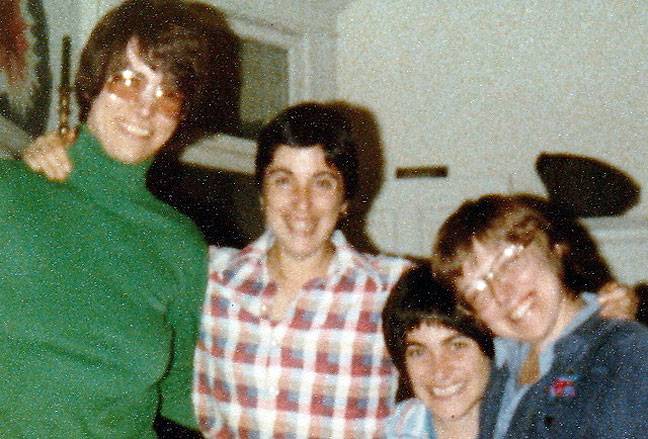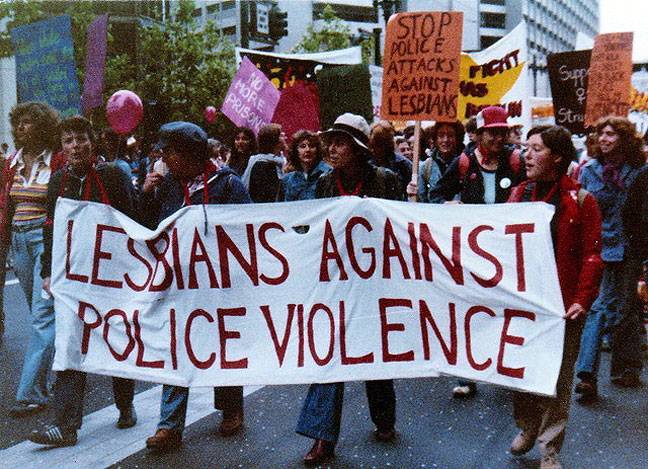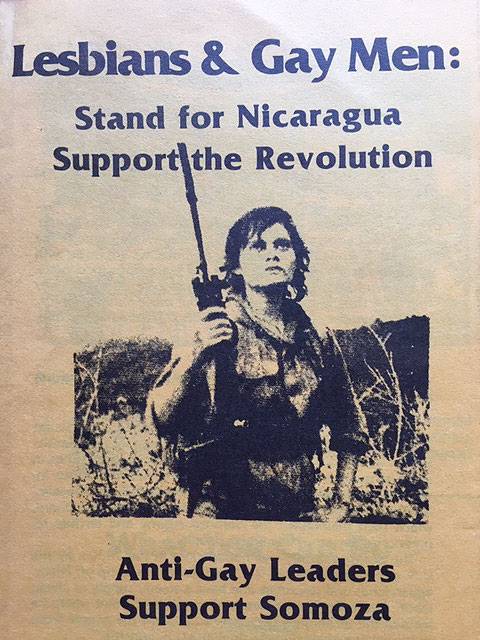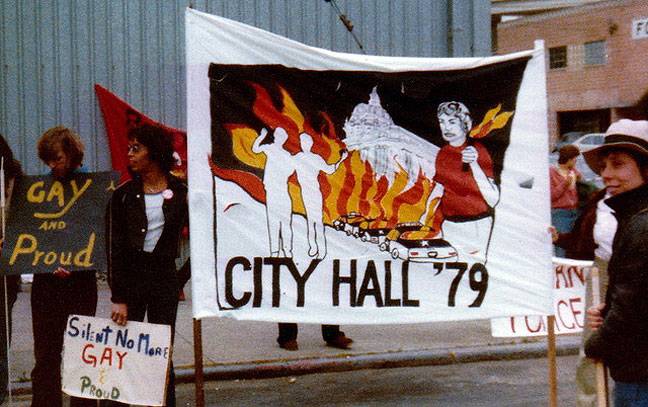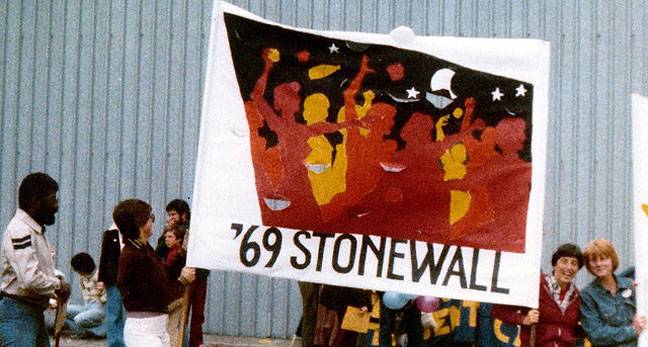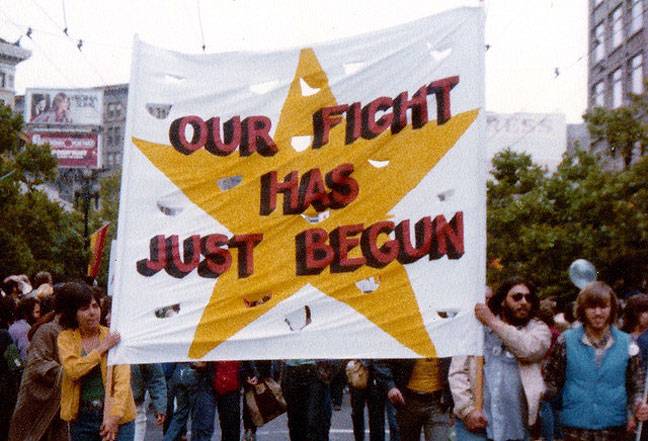How the Lesbians Invaded: Difference between revisions
No edit summary |
m (Protected "How the Lesbians Invaded" ([Edit=Allow only administrators] (indefinite) [Move=Allow only administrators] (indefinite))) |
(No difference)
| |
Latest revision as of 15:28, 8 August 2024
I was there . . .
by Molly Martin
Originally published on tradeswomn musings, October 2017.
We had been powerless tenants, evicted with no recourse, and then we became agents of displacement. There was no in between.
My collective household of four lesbians had found a place on Castro Street, one of those original Victorians with high ceilings and elaborate wood trim, an abandoned coal fireplace and a parlor whose big sliding doors opened to double the size of the room. It was rumored that the apartment had come up for rent because the previous tenants had been busted for selling weed and were all in jail. We embellished the story to claim that the famous Brownie Mary had lived there. She may not have lived there, but she had certainly been there in spirit. It was the seventies; the Castro was becoming a gay men’s mecca. During our time there a housepainter engaged to paint our building ran a brothel turning tricks in the building’s storage room. He painted that building for months.
We fondly remember political gabfests at shared dinners, Seders in which we sang all the way through, inventive costumes at Halloween parties (in the year of Anita Bryant I came as a lesbian recruiter). For a time our costume du jour at home was simply a vest, a way to show off a billowing bush and legs as thickly furred as animal pelts (we were hairy and proud!). We danced and sang along to Stevie Wonder and Lavender Jane Loves Women. There was much laughing and also much crying. Passionate love affairs abounded. Hearts were opened, hearts were broken. Creating a new culture calls for invention. We tried out nonmonogamy, polyamory. We felt we were on the cutting edge of a cultural transformation.
The original collective: me, Pam, Ruth S and Ruth M about 1978
Photos: courtesy Molly Martin
When the gay male couple from New York, or maybe LA, bought the three-unit building in 1978 they immediately evicted us. We had no recourse; rent control was still a few years off. We found a smaller apartment on 29th Street just off Mission in the neighborhood we now call La Lengua. Our landlords were butchers, brothers who ran a shop on Mission right next to what later became Cole Hardware. Weirdly, the buildings on 29th Street and Mission Street were connected. Our apartment always smelled like dead meat, like something had died in the walls.
We liked the spot—right behind the Safeway parking lot and across the street from the Tiffany gas station. Pauline’s Pizza was just across Mission and Mexican restaurants like Mi Casa proliferated. I bought my work clothes at Lightstone’s; the post office was right next door. The building’s ground floor held a printer’s shop (it’s now a pot club) and the second floor was just a big meeting room that was rented by Union Women’s Alliance to Gain Equality (Union WAGE) which allowed other organizations like Tradeswomen, Gays for Nicaragua, Lesbians Against Police Violence and the Briggs Initiative opposition to meet there.
Photos: Ruth Mahaney
My collective of four politically active dykes—me, two Ruths and a Pam—was happy. We cooked and ate together and invited interesting people to share dinner. Jews and militant atheists ruled. I learned about Jewish culture. The Christmas tree was relegated to a bedroom. It was bliss, except that with visiting lovers and pets (one a gigantic great Dane) and parents and friends the place was just too small. Finally we decided that we either had to pool our money and buy a bigger place or split up the collective. Ruth M decided to pull up stakes and live with her lover and so my lover Nancy became part of our collective.
We were earnest idealists; we were gay activists; we had just lived through the horrors of the Moscone/Milk murders and Jonestown and the election of Reagan. We were committed to live ethically and, even in the midst of what felt like political chaos, we fervently believed we could change the world, ending US imperialism, racism, police violence, and discrimination against women and gays. We were part of a collective movement that emphasized cooperation and consensus decision-making, a radical departure from capitalist organization that resulted only in winners and losers.
We listed our requirements for the new house. Ruth had to have a garden. I desperately needed a garage to store my electrical contracting tools and supplies. We had to be close to public transportation. We didn’t want a fixer upper; no one had time for that and I was the only skilled tradeswoman. We were committed to collective living and we also fantasized about eventually dispensing with private property. What if we could donate the place to a land trust so that our dream of a lesbian nation could live on into future generations?
We negotiated a contract. What would happen if one of us died or ended up in jail or for some reason couldn’t make her payment? How would we sell and buy shares in the building? What if we needed to make repairs or improvements? We listed all contingencies. We were good at processing—we were lesbians!
We imagined a larger single-family house, one with four real bedrooms, but then when we found the three-unit place on the south side of Bernal Hill our imaginations blossomed. We would no longer have to share one bathroom and one kitchen, but we could still cook and eat together whenever we wanted. Instead of negotiating for time to call each of our telephone trees on our shared phone, each could have her own phone.
The listing price was $135,000, an incomprehensible amount. A hundred thousand then felt like like a billion now—you couldn’t get your head around it. Still, we dug deep and came up with the down payment, only because Pam was able to borrow money from her family. Then we wrote up a new contract to repay Pam by the month. We got pretty good at writing contracts.
Photos: Ruth Mahaney
As soon as we took possession in 1980, our place in the property hierarchy changed. We became agents of displacement. All three of the units were occupied. Each of us had to evict tenants before we could move in and none of us could afford to pay both rent and mortgage for long. Oh the contradictions! I talked with the couple in “my” unit, offering to help them find a new place. Our exchanges were friendly and civil, and they soon found new housing. But Ruth couldn’t even get the tenant in “her” unit to open his door, though she could hear him spewing expletives from the other side. She resorted to lawyers and eviction notices.
We weren’t the first lesbians to move to Bernal Heights. Political activist Pat Norman and her large family lived up the block. A lesbian couple had settled just around the corner on Andover. But there were four of us, and with friends and lovers coming and going we were hard to ignore. People in the neighborhood noticed. Homophobia took the form of nasty notes left on car windshields, DYKES graffiti on the building. Two neighbors who grew up on the block, guys about my age, made it clear they understood what we represented—a lesbian invasion. Years later, when our relationship had grown friendlier, one of them confided, “We were watching you.”
As much as we wanted to live collectively, the house on Richland restricted collectivity. Having separate apartments led to fewer shared meals, less knowledge of each other’s daily lives. I retreated into the dreaded merged lesbian couple relationship. After a few years the original members began to sell their shares and move out while others bought in. At the cusp of the 80s our world changed. That frantic hopeful creative collective time was ending.
But we are still here. Since the birth of our dyke-owned dream, we have aided the lesbian colonizing of San Francisco and particularly Bernal Heights. With each refinancing (too numerous to count) and buyout, our property underwrote the purchase of new female-owned houses. When we started, four single women buying property together was rare and suspect by financiers. Tenants-in-common was not a typical way to hold property. Since then it’s been adopted by the real estate industry as a way to make buying of increasingly expensive property possible for groups of unrelated individuals.
We were agents of change, the leading edge of a new wave of homeowners in the Mission and Bernal Heights. But change is not new to our neighborhood. As one of the authors of a small history of Bernal Heights, I researched its historic demographics. Irish squatters displaced the Mexican land grant Californios. European immigrants made homeless by the 1906 earthquake and fire moved earthquake shacks here and built new homes. Southern Italians colonized the north side of the hill. Germans, Swedes and Italians built churches here for ethnic congregations. Mexicans and blacks found a neighborhood free of racist covenants and restrictions, although Bernal was not outside redlining boundaries. During the economic downturn starting in 2008, big banks (locally based Wells Fargo gained our enduring hatred) evicted scores of homeowners, most of them people of color. Now houses on this block are selling for millions and the techies are moving in.
The life we built is changing. Pat Norman retired, sold her house and moved to Hawaii. My long-time friend on Andover, the first lesbian I met in the neighborhood, sold her house and moved to Oakland. And now I’m selling the apartment where I’ve lived for 37 years in order to colonize a neighborhood in Santa Rosa. Our particular experiment may be ending, but the neighborhood is still full of dykes.
In Bernal Heights, lesbians found an affordable generally accepting environment. At one time I heard that the neighborhood was home to more woman-owned property than any neighborhood in the country or in the world. Who knows; that may still be true.


